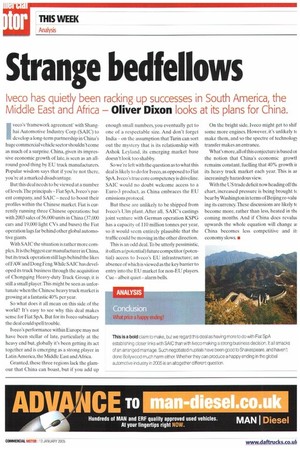Strange bedfellows
Page 16

If you've noticed an error in this article please click here to report it so we can fix it.
Iveco has quietly been racking up successes in South America, the Middle East and Africa — Oliver Dixon looks at its plans for China.
Iveco's 'framework agreement' with Shanghai Automotive Industry Corp (SAIC) to develop a long-term partnership in China's huge commercial vehicle sector shouldn't come as much of a surprise. China, given its impressive economic growth of late, is seen as an allround good thing by EU truck manufacturers. Popular wisdom says that if you're not there, you're at a marked disadvantage.
But this deal needs to be viewed at a number of levels. The principals — Fiat SpA, Iveco's parent company, and SAIC — need to boost their profiles within the Chinese market. Fiat is currently running three Chinese operations: but with 2003 sales of 56,000 units in China (37,000 cars and 19,000 light CVs and buses) the Fiat operation lags far behind other global automotive giants.
With SAIC the situation is rather more complex. It is the biggest car manufacturer in China, but its truck operation still lags behind the likes of FAW and Dong Feng. While SAIC has developed its truck business through the acquisition of Chongqing Heavy-duty Truck Group, it is still a small player. This might be seen as unfortunate when the Chinese heavy truck market is growing at a fantastic 40% per year So what does it all mean on this side of the world? It's easy to see why this deal makes sense for Fiat SpA. But for its Iveco subsidiary the deal could spell trouble.
Iveco's performance within Europe may not have been stellar of late, particularly at the heavy end but, globally it's been getting its act together and is emerging as a strong player in Latin America, the Middle East and Africa.
Granted, these three regions lack the glamour that China can boast, but if you add up enough small numbers, you eventually get to one of a respectable size. And don't forget India — on the assumption that Turin can sort out the mystery that is its relationship with Ashok Leyland, its emerging market base doesn't look too shabby.
So we're left with the question as to what this deal is likely to do for Iveco, as opposed to Fiat SpA. lveco's true core competency is driveline. SAIC would no doubt welcome access to a Euro-3 product. as China embraces the EU emissions protocol.
But these are unlikely to be shipped from Iveco's Ulm plant. After all, SAIC's castings joint venture with German operation KSPG has a capacity of 110 million tonnes per year, so it would seem entirely plausible that the traffic could be moving in the other direction.
This is an odd deal. To be utterly pessimistic, it offers a (potential) future competitor (potential) access to Iveco's EU infrastructure; an absence of which is viewed as the key barrier to entry into the EU market for non-EU players. Cue— albeit quiet —alarm bells. On the bright side, Iveco might get to shif some more engines. However, it's unlikely tc make them, and so the spectre of technoloD transfer makes an entrance.
What's more,all of this conjecture is based or the notion that China's economic growt1 remains constant, fuelling that 40% growth it its heavy truck market each year. This is ar increasingly hazardous view.
With the US trade deficit now heading off tht chart, increased pressure is being brought tc bear by Washington in terms of Beijing re-valu ing its currency. These discussions are likely tc become more, rather than less, heated in tht coming months. And if China does revalut upwards the whole equation will change a: China becomes less competitive and it economy slows. •






















































































































































































